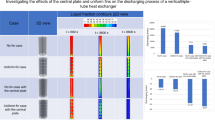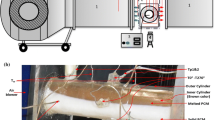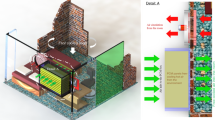Abstract
In the present work, effects of various heat transfer fluids on the discharging performance of a phase change material (PCM) included cylindrical container are numerically assessed during forced convection. The heat transfer fluid air, hydrogen, water and nanofluid with alumina particles are used and the the geometric variation of the PCM embedded region is also considered. The finite element method is used as the solver. Dynamic features of heat exchange with various phases are explored for different heat transfer fluid types, Reynolds number (between 100 and 300) and PCM embedded region geometric variation (hx between 0.01d1 and 0.65d1, hy between 0.1h1 and 0.4h1). It is observed that discharging time is significantly influenced by the heat transfer fluid type while full phase transition time for air is obtained as more than 10 times when hydrogen is utilized as heat transfer fluid. The best performance is achieved with nanofluid. When the PCM integrated region size is reduced, discharging time is generally reduced while due to the form of the geometry, vortex formation is established in the PCM region. This results in performance degeneration at the highest radius and height of the inner cylinder. Discharging time increases by about 12% when radius of the inner cylinder is increased from hx=0.35d1 to hx=0.45d1. Dynamic features of PCM temperature and liquid fraction are affected with Reynolds number while discharging time is reduced by about 48% when configurations with the lowest and highest Reynolds number are compared.
摘要
本文采用数值模拟方法研究了强制对流条件下不同传热流体对含相变材料柱形容器的放热性能 的影响。以空气、氢、水和含氧化铝颗粒的纳米流体作为传热流体, 同时考虑了含相变材料(PCM)区 域的结构变化, 采用有限元法进行求解。研究了不同传热流体类型、雷诺数(100∼300)和含PCM 区域 结构变化(hx 在0.01d1∼0.65d1, hy 在0.1h1∼0.4h1) 下不同相的换热动力学特征。研究发现, 换热流体类型 对放热时间影响较大, 以空气为换热流体时相变完成时间比以空气为换热流体时的长10 倍以上, 而以 纳米流体为换热流体时的时间最短。当含PCM 区域减小时, 放热时间缩短。含PCM 区域的结构导致 涡流的形成, 这使在内筒的半径和高度最大处的性能下降。当内筒半径从hx =0.35d1 增加到hx =0.45d1 时, 放热时间延长约12%。在不同雷诺数下, PCM 的温度和液体组分的动态特性均受雷诺数的影响, 与最小雷诺数相比, 最大雷诺数下的PCM 的放电时间缩短了48% 左右。
Similar content being viewed by others
Abbreviations
- k :
-
Thermal conductivity
- H :
-
Radius of cylinder
- L :
-
Cylinder length
- L f :
-
Latent heat of fusion
- n :
-
Unit normal vector
- N :
-
Number of waves
- Nu :
-
Nusselt number
- p :
-
Pressure
- Pr :
-
Prandtl number
- Re :
-
Reynolds number
- T :
-
Temperature
- T m :
-
Melting temperature
- u, v, w :
-
Velocity components
- r, z :
-
Cylindrical coordinates
- ν :
-
Kinematic viscosity
- ρ :
-
Density of the fluid
- ε :
-
Porosity
- κ :
-
Permeability
- φ :
-
Solid volume fraction
- m:
-
Average
- c:
-
Cold
- h:
-
Hot
- nf:
-
Nanofluid
- p:
-
Solid particle
References
MAZMAN M, CABEZA L F, MEHLING H, NOGUES M, EVLIYA H, PAKSOY H Ö. Utilization of phase change materials in solar domestic hot water systems [J]. Renewable Energy, 2009, 34(6): 1639–1643. DOI: https://doi.org/10.1016/j.renene.2008.10.016.
HEYHAT M M, MOUSAVI S, SIAVASHI M. Battery thermal management with thermal energy storage composites of PCM, metal foam, fin and nanoparticle [J]. Journal of Energy Storage, 2020, 28: 101235. DOI: https://doi.org/10.1016/j.est.2020.101235.
GIL A, ORÓ E, MIRÓ L, PEIRÓ G, RUIZ Á, SALMERÓN J M, CABEZA L F. Experimental analysis of hydroquinone used as phase change material (PCM) to be applied in solar cooling refrigeration [J]. International Journal of Refrigeration, 2014, 39: 95–103. DOI: https://doi.org/10.1016/j.ijrefrig.2013.05.013.
MOUSAVI S, SIAVASHI M, HEYHAT M M. Numerical melting performance analysis of a cylindrical thermal energy storage unit using nano-enhanced PCM and multiple horizontal fins [J]. Numerical Heat Transfer, Part A: Applications, 2019, 75(8): 560–577. DOI: https://doi.org/10.1080/10407782.2019.1606634.
YANG Hua, LIU Yun, KONG Xiang-fei, CHEN Wan-he, YAO Cheng-qiang. Preparation and hygrothermal performance of composite phase change material wallboard with humidity control based on expanded perlite/diatomite/paraffin [J]. Journal of Central South University, 2018, 25(10): 2387–2398. DOI: https://doi.org/10.1007/s11771-018-3923-4.
SAKKAKI M, SADEGH MOGHANLOU F, PARVIZI S, BAGHBANIJAVID H, BABAPOOR A, SHAHEDI ASL M. Phase change materials as quenching media for heat treatment of 42CrMo4 steels [J]. Journal of Central South University, 2020, 27(3): 752–761. DOI: https://doi.org/10.1007/s11771-020-4328-8.
XU Peng, LU Jian, LI Tai-lu, ZHU Jia-ling. Thermodynamic optimization and fluid selection of organic Rankine cycle driven by a latent heat source [J]. Journal of Central South University, 2017, 24(12): 2829–2841. DOI: https://doi.org/10.1007/s11771-017-3698-z.
HARITI Y, HADER A, FARAJI H, BOUGHALEB Y. Scaling law of permeability and porosity for fluid transport phenomena in porous PCM media [J]. Journal of Applied and Computational Mechanics, 2021, 7(1): 84–92. DOI: https://doi.org/10.22055/JACM.2020.35136.2577.
BOUZENNADA T, MECHIGHEL F, FILALI A, KOLSI L. Study of the usability of sinusoidal function heat flux based on enthalpy-porosity technique for PCM-related applications [J]. Journal of Thermal Analysis and Calorimetry, 2020, 141(5): 1769–1784. DOI: https://doi.org/10.1007/s10973-019-09192-7.
ZHOU Tian, MA Xiao-yi, LIU Xu, LI Yuan. Quantitative analysis on influencing factors for interface propagation-based thermal conductivity measurement method during solid-liquid transition [J]. Journal of Central South University, 2019, 26(8): 2041–2055. DOI: https://doi.org/10.1007/s11771-019-4152-1.
REGIN A F, SOLANKI S C, SAINI J S. Heat transfer characteristics of thermal energy storage system using PCM capsules: A review [J]. Renewable and Sustainable Energy Reviews, 2008, 12(9): 2438–2458. DOI: https://doi.org/10.1016/j.rser.2007.06.009.
de GRACIA A, CABEZA L F. Numerical simulation of a PCM packed bed system: A review [J]. Renewable and Sustainable Energy Reviews, 2017, 69: 1055–1063. DOI: https://doi.org/10.1016/j.rser.2016.09.092.
GAO Long, GEGENTAN A, LIU Zhong-ze, SUN Bai-zhong, CHE De-yong, LI Shao-hua. Multi-objective optimization of thermal performance of packed bed latent heat thermal storage system based on response surface method [J]. Renewable Energy, 2020, 153: 669–680. DOI: https://doi.org/10.1016/j.renene.2020.01.157.
NALLUSAMY N, SAMPATH S, VELRAJ R. Experimental investigation on a combined sensible and latent heat storage system integrated with constant/varying (solar) heat sources [J]. Renewable Energy, 2007, 32(7): 1206–1227. DOI: https://doi.org/10.1016/j.renene.2006.04.015.
SHEIKHOLESLAMI M. Numerical modeling of nano enhanced PCM solidification in an enclosure with metallic fin [J]. Journal of Molecular Liquids, 2018, 259: 424–438. DOI: https://doi.org/10.1016/j.molliq.2018.03.006.
TARIQ S L, ALI H M, AKRAM M A, JANJUA M M, AHMADLOUYDARAB M. Nanoparticles enhanced phase change materials (NePCMs)—A recent review [J]. Applied Thermal Engineering, 2020, 176: 115305. DOI: https://doi.org/10.1016/j.applthermaleng.2020.115305.
ROSTAMI S, AFRAND M, SHAHSAVAR A, SHEIKHOLESLAMI M, KALBASI R, AGHAKHANI S, SHADLOO M S, OZTOP H F. A review of melting and freezing processes of PCM/nano-PCM and their application in energy storage [J]. Energy, 2020, 211: 118698. DOI: https://doi.org/10.1016/j.energy.2020.118698.
ZHANG Xiao-jian, SHEIKHOLESLAMI M, YAN W M, SHAFEE A, SELIMEFENDIGIL F, BABAZADEH H. Energy storage analysis for discharging of nanoparticle enhanced phase change material within a triplex-tube thermal storage [J]. Journal of Energy Storage, 2020, 31: 101640. DOI: https://doi.org/10.1016/j.est.2020.101640.
KALBASI R, AFRAND M, ALSARRAF J, TRAN M D. Studies on optimum fins number in PCM-based heat sinks [J]. Energy, 2019, 171: 1088–1099. DOI: https://doi.org/10.1016/j.energy.2019.01.070.
MAT S, AL-ABIDI A A, SOPIAN K, SULAIMAN M Y, MOHAMMAD A T. Enhance heat transfer for PCM melting in triplex tube with internal-external fins [J]. Energy Conversion and Management, 2013, 74: 223–236. DOI: https://doi.org/10.1016/j.enconman.2013.05.003.
EMIR S, PAKSOY H. New multilayered microencapsulated phase change material with CaCO3 and Ag shells [J]. Energy Storage, 2021, 3(1): e214. DOI: https://doi.org/10.1002/est2.214.
CHAMKHA A J, MIROSHNICHENKO I V, SHEREMET M A. Numerical analysis of unsteady conjugate natural convection of hybrid water-based nanofluid in a semicircular cavity [J]. Journal of Thermal Science and Engineering Applications, 2017, 9(4): 041004. DOI: https://doi.org/10.1115/1.4036203.
TOGHRAIE D, HEKMATIFAR M, SALEHIPOUR Y, AFRAND M. Molecular dynamics simulation of Couette and Poiseuille Water-Copper nanofluid flows in rough and smooth nanochannels with different roughness configurations [J]. Chemical Physics, 2019, 527: 110505. DOI: https://doi.org/10.1016/j.chemphys.2019.110505.
BORODE A, AHMED N, OLUBAMBI P. A review of solar collectors using carbon-based nanofluids [J]. Journal of Cleaner Production, 2019, 241: 118311. DOI: https://doi.org/10.1016/j.jclepro.2019.118311.
GOODARZI H, AKBARI O A, SARAFRAZ M M, KARCHEGANI M M, SAFAEI M R, SHEIKH SHABANI G A. Numerical simulation of natural convection heat transfer of nanofluid with Cu, MWCNT, and Al2O3 nanoparticles in a cavity with different aspect ratios [J]. Journal of Thermal Science and Engineering Applications, 2019, 11(6): 061020. DOI: https://doi.org/10.1115/1.4043809.
SAQIB M, KHAN I, SHAFIE S. Shape effect in magnetohydrodynamic free convection flow of sodium alginate-ferrimagnetic nanofluid [J]. Journal of Thermal Science and Engineering Applications, 2019, 11(4): 041019. DOI: https://doi.org/10.1115/1.4044201.
XIONG Qin-gang, JAFARYAR M, DIVSALAR A, SHEIKHOLESLAMI M, SHAFEE A, VO D D, KHAN M H, TLILI I, LI Zhi-xiong. Macroscopic simulation of nanofluid turbulent flow due to compound turbulator in a pipe [J]. Chemical Physics, 2019, 527: 110475. DOI: https://doi.org/10.1016/j.chemphys.2019.110475.
TAHMASBI M, SIAVASHI M, ABBASI H R, AKHLAGHI M. Mixed convection enhancement by using optimized porous media and nanofluid in a cavity with two rotating cylinders [J]. Journal of Thermal Analysis and Calorimetry, 2020, 141(5): 1829–1846. DOI: https://doi.org/10.1007/s10973-020-09604-z.
SELIMEFENDIGIL F, ÖZTOP H F. Laminar convective nanofluid flow over a backward-facing step with an elastic bottom wall [J]. Journal of Thermal Science and Engineering Applications, 2018, 10(4): 041003. DOI: https://doi.org/10.1115/1.4038738.
ALSABERY A, TAYEBI T, CHAMKHA A, HASHIM I. Effects of non-homogeneous nanofluid model on natural convection in a square cavity in the presence of conducting solid block and corner heater [J]. Energies, 2018, 11(10): 2507. DOI: https://doi.org/10.3390/en11102507.
TAYEBI T, ÖZTOP H F, CHAMKHA A J. Natural convection and entropy production in hybrid nanofluid filled-annular elliptical cavity with internal heat generation or absorption [J]. Thermal Science and Engineering Progress, 2020, 19: 100605. DOI: https://doi.org/10.1016/j.tsep.2020.100605.
TAYEBI T, CHAMKHA A J. Effects of various configurations of an inserted corrugated conductive cylinder on MHD natural convection in a hybrid nanofluid-filled square domain [J]. Journal of Thermal Analysis and Calorimetry, 2021, 143(2): 1399–1411. DOI: https://doi.org/10.1007/s10973-020-10206-y.
MALEKI H, ALSARRAF J, MOGHANIZADEH A, HAJABDOLLAHI H, SAFAEI M R. Heat transfer and nanofluid flow over a porous plate with radiation and slip boundary conditions [J]. Journal of Central South University, 2019, 26(5): 1099–1115. DOI: https://doi.org/10.1007/s11771-019-4074-y.
TAYEBI T, CHAMKHA A J. MHD buoyancy-driven flow in a nanoliquid filled-square enclosure divided by a solid conductive wall [J]. Mathematical Methods in the Applied Sciences, 2020: 1–17. DOI: https://doi.org/10.1002/mma.6598.
AL-WAELI A H A, KAZEM H A, CHAICHAN M T, SOPIAN K. Experimental investigation of using nano-PCM/nanofluid on a photovoltaic thermal system (PVT): Technical and economic study [J]. Thermal Science and Engineering Progress, 2019, 11: 213–230. DOI: https://doi.org/10.1016/j.tsep.2019.04.002.
NASEF H A, NADA S A, HASSAN H. Integrative passive and active cooling system using PCM and nanofluid for thermal regulation of concentrated photovoltaic solar cells [J]. Energy Conversion and Management, 2019, 199: 112065. DOI: https://doi.org/10.1016/j.enconman.2019.112065.
ABDOLLAHZADEH M, ESMAEILPOUR M. Enhancement of phase change material (PCM) based latent heat storage system with nano fluid and wavy surface [J]. International Journal of Heat and Mass Transfer, 2015, 80: 376–385. DOI: https://doi.org/10.1016/j.ijheatmasstransfer.2014.09.007.
RAJABIFAR B. Enhancement of the performance of a double layered microchannel heatsink using PCM slurry and nanofluid coolants [J]. International Journal of Heat and Mass Transfer, 2015, 88: 627–635. DOI: https://doi.org/10.1016/j.ijheatmasstransfer.2015.05.007.
SHEIKHOLESLAMI M, MAHIAN O. Enhancement of PCM solidification using inorganic nanoparticles and an external magnetic field with application in energy storage systems [J]. Journal of Cleaner Production, 2019, 215: 963–977. DOI: https://doi.org/10.1016/j.jclepro.2019.01.122.
SELIMEFENDIGIL F, ÖZTOP H F. Impacts of magnetic field and hybrid nanoparticles in the heat transfer fluid on the thermal performance of phase change material installed energy storage system and predictive modeling with artificial neural networks [J]. Journal of Energy Storage, 2020, 32: 101793. DOI: https://doi.org/10.1016/j.est.2020.101793.
AL-ZAREER M, DINCER I, ROSEN M A. Performance assessment of a new hydrogen cooled prismatic battery pack arrangement for hydrogen hybrid electric vehicles [J]. Energy Conversion and Management, 2018, 173: 303–319. DOI: https://doi.org/10.1016/j.enconman.2018.07.072.
IZADI A, SIAVASHI M, XIONG Qin-gang. Impingement jet hydrogen, air and CuH2O nanofluid cooling of a hot surface covered by porous media with non-uniform input jet velocity [J]. International Journal of Hydrogen Energy, 2019, 44(30): 15933–15948. DOI: https://doi.org/10.1016/j.ijhydene.2018.12.176.
MOHAMMADNEJAD F, HOSSAINPOUR S. A CFD modeling and investigation of a packed bed of high temperature phase change materials (PCMs) with different layer configurations [J]. Journal of Energy Storage, 2020, 28: 101209. DOI: https://doi.org/10.1016/j.est.2020.101209.
NIELD D, BEJAN A. Convection in porous media [M]//Convection Heat Transfer. Hoboken: John Wiley & Sons, 2013.
COMSOL. COMSOL User’s Guide [M]. COMSOL, 2018.
WAKAO N, KAGUEI S, FUNAZKRI T. Effect of fluid dispersion coefficients on particle-to-fluid heat transfer coefficients in packed beds: Correlation of nusselt numbers [J]. Chemical Engineering Science, 1979, 34(3): 325–336. DOI: https://doi.org/10.1016/0009-2509(79)85064-2.
LIU Fang, CAI Yang, WANG Li-qiu, ZHAO Jun. Effects of nanoparticle shapes on laminar forced convective heat transfer in curved ducts using two-phase model [J]. International Journal of Heat and Mass Transfer, 2018, 116: 292–305. DOI: https://doi.org/10.1016/j.ijheatmasstransfer.2017.08.097.
TIMOFEEVA E V, ROUTBORT J L, SINGH D. Particle shape effects on thermophysical properties of alumina nanofluids [J]. Journal of Applied Physics, 2009, 106(1): 014304. DOI: https://doi.org/10.1063/1.3155999.
TROPEA C D, GACKSTATTER R. The flow over two-dimensional surface-mounted obstacles at low Reynolds numbers [J]. Journal of Fluids Engineering, 1985, 107(4): 489–494. DOI: https://doi.org/10.1115/1.3242518.
Author information
Authors and Affiliations
Contributions
SELİMEFENDİGİL Fatih provided the concept, conducted the literature review and performed the numerical simulations. ŞÍRÍN Ceylin edited the draft of manuscript. ÖZTOP Hakan F. performed validation and edited the draft of manuscript.
Corresponding author
Additional information
Conflict of interest
SELİMEFENDİGİL Fatih, ŞİRİN Ceylin and ÖZTOP Hakan F. declare that they have no conflict of interest.
Rights and permissions
About this article
Cite this article
Selimefendigil, F., Şirin, C. & Öztop, H.F. Effect of different heat transfer fluids on discharging performance of phase change material included cylindrical container during forced convection. J. Cent. South Univ. 28, 3521–3533 (2021). https://doi.org/10.1007/s11771-021-4872-x
Received:
Accepted:
Published:
Issue Date:
DOI: https://doi.org/10.1007/s11771-021-4872-x




